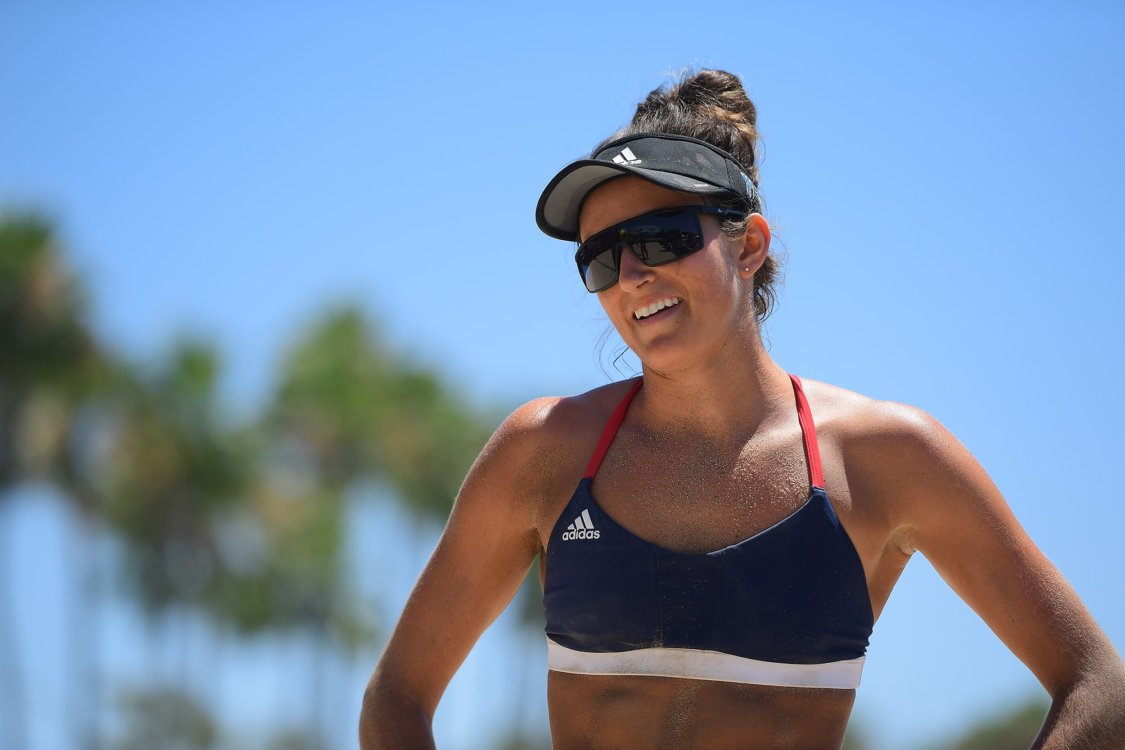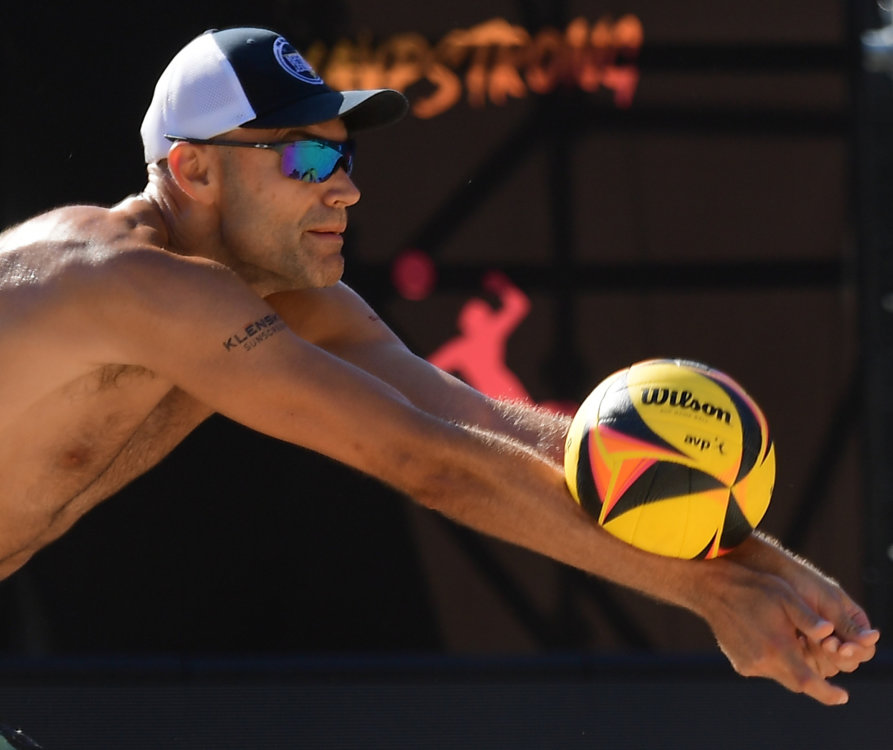Setting. An elusive art and one of the most intricate parts of the beach volleyball game.
While serving starts the point and passing is key to any play, setting is a huge difference-maker between crushing your opponent and barely staying alive. A good set makes your partner look like a stud; a bad set makes defense for your opponent a walk in the park… or in the sand, I guess.
There are two common methods of setting: bump setting and hand setting. I’ve seen a tomahawk and pokey set on tight passes or scramble plays, but those techniques will be reserved for the Setting 201 article.

Bump setting is every volleyball players’ bread and butter – the style they likely first learned and one that everyone uses at some point in a match. Bump setting is done with forearms in the exact same form as passing. Bump-setting is basic but effective. There’s no chance your hands are going to get “called” – the term used when a ref calls a double or lift (check our volleyball lingo for more on those). But on the flip side: there’s more room for variation in set-placement and control. This is why hand-setting is preferred by so many top players.
There are plenty of elite beach volleyball players that stick to bump setting, though. Misty May-Treanor, three-time Gold Medal Olympian and standout indoor setter during her college years at Long Beach State, chose to bump set her entire illustrious beach career. Melissa Humana-Parades, a phenomenal hand setter who was FIVB’s 2019 Setter of the Year, will tell you her partner Sarah Pavan puts up some juicy bump sets. And yours truly prefers the steadiness of my forearms to the unpredictability of my hands.
Though I’m in great company with my bump setters, hand setting is becoming the go-to for many of the top beach players. Especially the newly graduated college players who started young and had great coaches in school – players like Sarah Sponcil.

Sarah is my roommate; we talk about volleyball often, and I’m constantly learning from her. Her hands are just gorgeous. Sarah’s sets are clean no matter where she’s at on the court, and they’re perfectly placed for optimal offense from her partner, Kelly Claes. I wanted this interview to be the impetus of my new hand setting career by sheer osmosis. I wanted quick tips and easy tricks. But, it didn’t take me long to realize that wasn’t going to happen. As previously stated, setting is an art, one that you can’t listen to or read about and translate into action. You have to go do it.
Since Sarah was six-years-old, her dad encouraged her to be a setter. Before school, they’d go to the basketball court and set endless balls into the hoop. Those reps gave her the foundation to set for her indoor teams. Years later, her beach coach at LMU – John Mayer (no, not the singer) – gave her the confidence to use her hands on the beach. “John Mayer kind of forced me,” Sarah laughs. “And him encouraging me was my breakthrough.”
There’s quite a difference in setting indoor versus setting on the beach. “In indoor, you’re taking the ball a lot higher,” Sarah says. “You can set quicker and run more plays. It’s all about quick hands. In beach, you’re always trying to find that apex, so people bring the ball down way past their forehead, basically to their chin.” This half-second more contact gives the volleyball controlled lift. In beach, the passer immediately becomes the hitter. Beach sets need to be higher and more predictable than indoor because beach players are transitioning from one role to the next in seconds.

Though I couldn’t absorb all of Sarah’s diligently executed reps, something I could learn and translate immediately was her thought process. She says when your partner is served, most people rush in and close themselves off to the play. “Don’t rush in. Wait to see where the pass is.” Sarah barely moves when Kelly is served. Instead, she opens up to her and waits to see where the pass goes. She creates a point of hesitation and anticipation that allows her to react to the pass no matter where it is.
Her next thought is, “getting my feet around the ball as much as possible.” This is volley speak for moving to where the ball is and facing the spot where you’re going to set it. It’s also called squaring up, and squaring up is the same for bump setting and hand setting. “In indoor – you’re supposed to square up to the antenna or the pole. But in beach, it’s so situational. You should square up to show your partner where it’s going. I like to go at a 45-degree angle to the net.”
Disclaimer: where to square up is not agreed upon by all players and coaches. Some beach players face the antenna, some are perpendicular to the net, some are like Sarah and go 45-degree angle. This is discretionary.
Moving on – Sarah also says there needs to be forward motion in the set. “I’m never off-balance,” she says. “Once you get your feet there, you guide the ball by stepping into it and giving your momentum forward.” This allows her to dish a perfect set when she’s all the way at the end line or push the ball to the antenna when Kelly calls for an outside set.
With this knowledge and tens of thousands of setting reps, Sarah believes hand setting is far superior to bump setting. “You have more control. You can add tempo. I encourage people to get their hands on every ball, even if it’s at the backline. You just have so much more control. And if you bring it down here…” At this point, Sarah has a ball in her hands and is showing me the form. She has four fingers on each hand holding the ball, all the way down to where her fingers meet her palms. Her pinkies are slightly raised. The ball is right in front of her face, centered around her chin. “If you bring it down here, and you’re on the backline, you have so much more leverage with your legs to bring it up. Just make it quick.”
This simultaneous catch-and-release is how Sarah turns a spinning dig or pass into a buttery set. “A lot of people put their hands away when they see a really spinny ball. But I’m thinking, ‘How do I quickly make this ball not have spin?’ It sounds so basic, and it’s obviously harder the more it spins. But I would never look at a ball that’s spinning a bunch and decide not to hand-set it.”
It sounds so basic, and it’s obviously harder should really be the title of this article. Sarah and I can explain how to bump set or how to hand set and the difference between them all day. But until you get out on the sand and try it yourself, you really never know which is right for you.
So my biggest setting advice is – go out there and set some balls.
